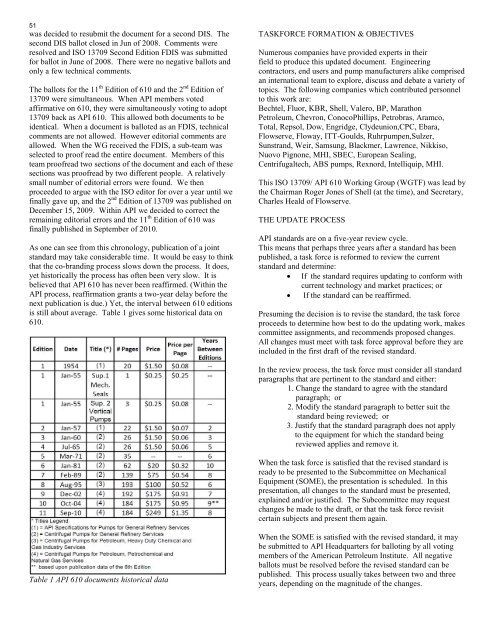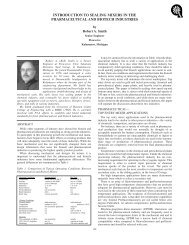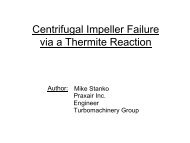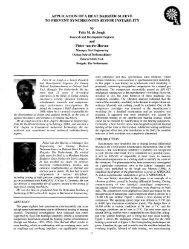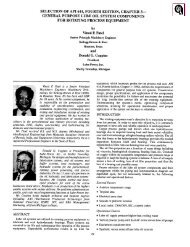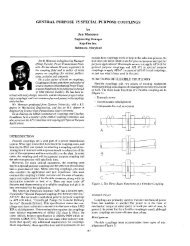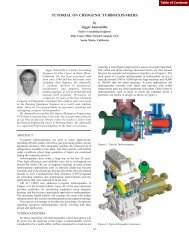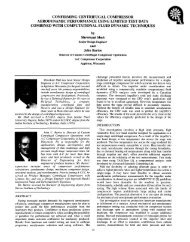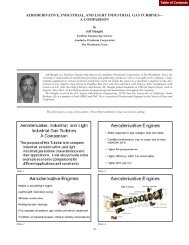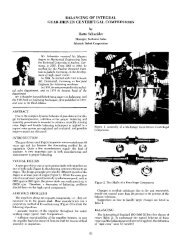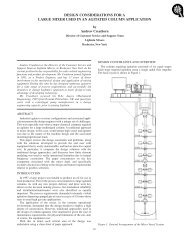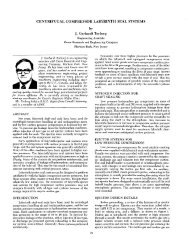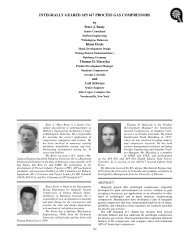ISO 13709 2nd Edition/ API 610 Eleventh Edition Highlights
ISO 13709 2nd Edition/ API 610 Eleventh Edition Highlights
ISO 13709 2nd Edition/ API 610 Eleventh Edition Highlights
You also want an ePaper? Increase the reach of your titles
YUMPU automatically turns print PDFs into web optimized ePapers that Google loves.
51<br />
was decided to resubmit the document for a second DIS. The<br />
second DIS ballot closed in Jun of 2008. Comments were<br />
resolved and <strong>ISO</strong> <strong>13709</strong> Second <strong>Edition</strong> FDIS was submitted<br />
for ballot in June of 2008. There were no negative ballots and<br />
only a few technical comments.<br />
The ballots for the 11 th <strong>Edition</strong> of <strong>610</strong> and the 2 nd <strong>Edition</strong> of<br />
<strong>13709</strong> were simultaneous. When <strong>API</strong> members voted<br />
affirmative on <strong>610</strong>, they were simultaneously voting to adopt<br />
<strong>13709</strong> back as <strong>API</strong> <strong>610</strong>. This allowed both documents to be<br />
identical. When a document is balloted as an FDIS, technical<br />
comments are not allowed. However editorial comments are<br />
allowed. When the WG received the FDIS, a sub-team was<br />
selected to proof read the entire document. Members of this<br />
team proofread two sections of the document and each of these<br />
sections was proofread by two different people. A relatively<br />
small number of editorial errors were found. We then<br />
proceeded to argue with the <strong>ISO</strong> editor for over a year until we<br />
finally gave up, and the 2 nd <strong>Edition</strong> of <strong>13709</strong> was published on<br />
December 15, 2009. Within <strong>API</strong> we decided to correct the<br />
remaining editorial errors and the 11 th <strong>Edition</strong> of <strong>610</strong> was<br />
finally published in September of 2010.<br />
As one can see from this chronology, publication of a joint<br />
standard may take considerable time. It would be easy to think<br />
that the co-branding process slows down the process. It does,<br />
yet historically the process has often been very slow. It is<br />
believed that <strong>API</strong> <strong>610</strong> has never been reaffirmed. (Within the<br />
<strong>API</strong> process, reaffirmation grants a two-year delay before the<br />
next publication is due.) Yet, the interval between <strong>610</strong> editions<br />
is still about average. Table 1 gives some historical data on<br />
<strong>610</strong>.<br />
TASKFORCE FORMATION & OBJECTIVES<br />
Numerous companies have provided experts in their<br />
field to produce this updated document. Engineering<br />
contractors, end users and pump manufacturers alike comprised<br />
an international team to explore, discuss and debate a variety of<br />
topics. The following companies which contributed personnel<br />
to this work are:<br />
Bechtel, Fluor, KBR, Shell, Valero, BP, Marathon<br />
Petroleum, Chevron, ConocoPhillips, Petrobras, Aramco,<br />
Total, Repsol, Dow, Engridge, Clydeunion,CPC, Ebara,<br />
Flowserve, Floway, ITT-Goulds, Ruhrpumpen,Sulzer,<br />
Sunstrand, Weir, Samsung, Blackmer, Lawrence, Nikkiso,<br />
Nuovo Pignone, MHI, SBEC, European Sealing,<br />
Centrifugaltech, ABS pumps, Rexnord, Intelliquip, MHI.<br />
This <strong>ISO</strong> <strong>13709</strong>/ <strong>API</strong> <strong>610</strong> Working Group (WGTF) was lead by<br />
the Chairman Roger Jones of Shell (at the time), and Secretary,<br />
Charles Heald of Flowserve.<br />
THE UPDATE PROCESS<br />
<strong>API</strong> standards are on a five-year review cycle.<br />
This means that perhaps three years after a standard has been<br />
published, a task force is reformed to review the current<br />
standard and determine:<br />
• If the standard requires updating to conform with<br />
current technology and market practices; or<br />
• If the standard can be reaffirmed.<br />
Presuming the decision is to revise the standard, the task force<br />
proceeds to determine how best to do the updating work, makes<br />
committee assignments, and recommends proposed changes.<br />
All changes must meet with task force approval before they are<br />
included in the first draft of the revised standard.<br />
In the review process, the task force must consider all standard<br />
paragraphs that are pertinent to the standard and either:<br />
1. Change the standard to agree with the standard<br />
paragraph; or<br />
2. Modify the standard paragraph to better suit the<br />
standard being reviewed; or<br />
3. Justify that the standard paragraph does not apply<br />
to the equipment for which the standard being<br />
reviewed applies and remove it.<br />
When the task force is satisfied that the revised standard is<br />
ready to be presented to the Subcommittee on Mechanical<br />
Equipment (SOME), the presentation is scheduled. In this<br />
presentation, all changes to the standard must be presented,<br />
explained and/or justified. The Subcommittee may request<br />
changes be made to the draft, or that the task force revisit<br />
certain subjects and present them again.<br />
Table 1 <strong>API</strong> <strong>610</strong> documents historical data<br />
When the SOME is satisfied with the revised standard, it may<br />
be submitted to <strong>API</strong> Headquarters for balloting by all voting<br />
members of the American Petroleum Institute. All negative<br />
ballots must be resolved before the revised standard can be<br />
published. This process usually takes between two and three<br />
years, depending on the magnitude of the changes.


